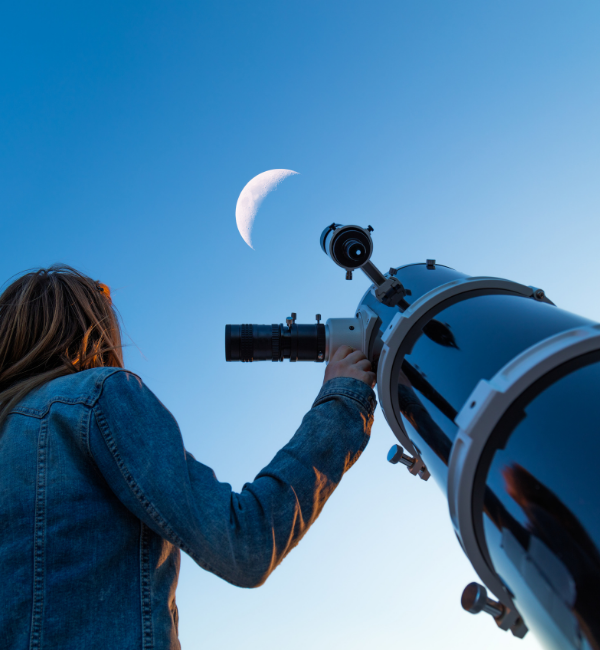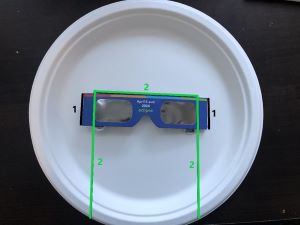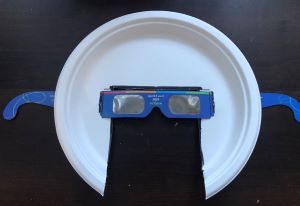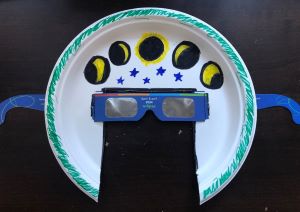Learn about the total solar eclipse


Get excited to view the total solar eclipse!
Learners will be introduced to the solar eclipses while decorating a headpiece showing the phases of a solar eclipse, that can be worn with their eclipse glasses. This activity can be done leading up to a solar eclipse (leaving the glasses behind for the group, so learners can safely experience the eclipse), or as part of an eclipse viewing event.
What You Need
- Eclipse glasses (Make sure to always wear approved eclipse glasses when looking at the Sun) - 1 per learner
- Paper plate (or circle of cardstock / thin cardboard, such as from a cereal box) – 1 per learner
- Colouring supplies
- Scissors
- Eclipse Observational Log – 1 per learner (optional)
- String and tape (optional)
Safety Notes
Safety is the #1 priority when viewing the solar eclipse. Make sure you and learners are safely wearing eclipse glasses before looking at the Sun to watch the eclipse. The most straightforward method for safeguarding your eyes is by using eclipse glasses. And remember - regular sunglasses are not appropriate for safely viewing an eclipse.
Younger learners may need help from an adult to cut their paper plates.
What To Do
- Introduce what a solar eclipse is, and that it happens in phases (see Discovery section below)
- Tip: Draw or share a picture of the phases of a solar eclipse.
- Discuss safety
Activity:
- Start by placing the eclipse glasses in the centre of the paper plate. Draw a line on either side of the glasses to mark where the arms will go through the plate (See lines #1).
- Tip: Based on the age group, you may want to help them mark the lines. Some learners may need help from an adult to cut their paper plates.
- Next, draw a line on the plate across the top of the glasses above the lenses. Connect these lines to the bottom of the plate to outline the space where your eyes, nose, and mouth will fit through.(see lines #2).

- Cut out lines #1 to make two slits for the arms of your eclipse glasses to fit through.
- Cut along lines #2 to make a large square-shaped opening from the bottom of your plate. The opening should be big enough for your mouth, nose, and eyes to fit through.

- Very gently, insert eclipse glasses into the slits, and test it out to see how well they fit. Adjust as needed so that it feels comfortable and so that you can see through the eye holes well. Be careful not to damage the glasses.
- Remove the glasses to avoid damaging them while drawing.
- Draw the phases of the solar eclipse on your plate by drawing 5 to 7 circles in a row and shading each in to show how the Moon blocks the Sun during an eclipse. The circle in the middle should show the Sun completely covered by the moon!
- Continue to decorate your headpiece with other objects you might find in space, such as stars and constellations.
- Insert your eclipse glasses back into the headpiece and you are now ready to view the eclipse safely and in style!

Options:
- Tape two pieces of string to the back of the plate to act as a head strap for keeping the glasses secure.
- Decorate the plates with the phases of the solar eclipse and other objects in space without cutting the plate into a headpiece.
Conclusion:
If you are facilitating this activity, but will not be with the group during the eclipse, conclude by talking to the group about what they can watch for and think about during the eclipse.
If you are facilitating this as part of an eclipse viewing event, ask learners to share what they saw and fill in their observational log afterwards. On the day of the eclipse, safely view the eclipse and watch to see the different phases as the appear. Make sure that your glasses are secure. Use the Eclipse Observational Log to draw what you see through your glasses and make notes about anything else you observe such as how the daylight changes as the phases progress. Are you able to see the different phases of the eclipse from your headpiece in real time?
Discovery
A solar eclipse occurs when the Moon passes between Earth and the Sun, blocking the view of the Sun from a small part of the Earth, causing a shadow to move across the Earth. A total solar eclipse occurs when the Moon completely covers the Sun’s bright face. If you are one of the lucky people to witness a total solar eclipse, the Moon will block out the entire Sun, leaving a glowing ring of light for a few spectacular minutes.
At the start of eclipse, the Moon will pass in front of the Sun and block a tiny section of the face of the Sun. This first contact is first only visible through a telescope before you can finally see it with the unaided eye. You MUST use eclipse glasses when looking at the sun! During the next phase, the Moon gradually covers more and more of the Sun's light. As the partial phase progresses, a dark shadow will grow over the Sun’s face. When the Moon completely blocks the Sun, this is called “totality.” During totality, the Sun is completely blocked and it might look like nighttime outside! You may see bright streams of light around the circle of the Sun and Moon. As the Moon begins to move away from the Sun, the crescent shape of the sun will start to grow and brighten. As the Moon continues to move away from the Sun, the bright crescent of the Sun will grow larger and larger. At the end of the Eclipse, none of the Sun will be covered by the Moon’s shadow. When the Sun’s face is completely free of any dark shapes from the Moon, the Eclipse is over.
For additional information about the sun, moon and eclipse:
A total solar eclipse – when the Moon passes between the Sun and the Earth, completely blocking out the Sun – is a rare occurrence. While a total solar eclipse occurs once in approximately 18 months and it is rare to be in the path of totality, meaning, it is rare to be in a location where the sun is completely blocked by the moon. You can find forecasts of solar eclipses online.
This activity can be adapted for younger learners. For younger ages, ensure proper support is provided for cutting with scissors.
What's Happening?
A solar eclipse occurs when the Moon passes between Earth and the Sun, blocking the view of the Sun from a small part of the Earth, causing a shadow to move across the Earth. A total solar eclipse occurs when the Moon completely covers the Sun’s bright face. If you are one of the lucky people to witness a total solar eclipse, the Moon will block out the entire Sun, leaving a glowing ring of light for a few spectacular minutes.
At the start of eclipse, the Moon will pass in front of the Sun and block a tiny section of the face of the Sun. This first contact is first only visible through a telescope before you can finally see it with the unaided eye. You MUST use eclipse glasses when looking at the sun! During the next phase, the Moon gradually covers more and more of the Sun's light. As the partial phase progresses, a dark shadow will grow over the Sun’s face. When the Moon completely blocks the Sun, this is called “totality.” During totality, the Sun is completely blocked and it might look like nighttime outside! You may see bright streams of light around the circle of the Sun and Moon. As the Moon begins to move away from the Sun, the crescent shape of the sun will start to grow and brighten. As the Moon continues to move away from the Sun, the bright crescent of the Sun will grow larger and larger. At the end of the Eclipse, none of the Sun will be covered by the Moon’s shadow. When the Sun’s face is completely free of any dark shapes from the Moon, the Eclipse is over.
For additional information about the sun, moon and eclipse:
Why Does it Matter?
A total solar eclipse – when the Moon passes between the Sun and the Earth, completely blocking out the Sun – is a rare occurrence. While a total solar eclipse occurs once in approximately 18 months and it is rare to be in the path of totality, meaning, it is rare to be in a location where the sun is completely blocked by the moon. You can find forecasts of solar eclipses online.
Investigate Further
This activity can be adapted for younger learners. For younger ages, ensure proper support is provided for cutting with scissors.